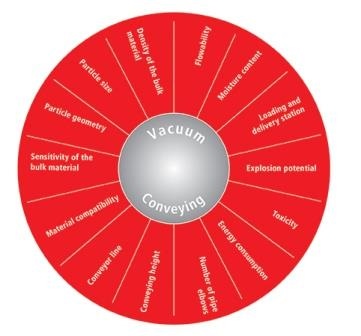Contained Powder Transfer: Vacuum-Based Pneumatic Conveying
June 12, 2015

By Nick Hayes, Volkmann Inc.
The containment of fine powders, granules, particles, tablets, and other small parts when being transported throughout the processing plant has become critically important to today’s manufacturer. Not only is there the expense of product waste, but the accumulation of dust in the plant that occurs when product escapes during transfer can lead to deadly explosions. Powder transfer via vacuum offers a solution by providing a contained environment for transport, thereby reducing explosion risk and cutting back on product waste. Some vacuum conveying systems offer the additional benefit of transporting without segregation or damage, making them the optimal choice in many situations. This article addresses how vacuum pneumatic conveying can deliver these results.
Vacuum-Based Pneumatic Conveying for Transportation of Bulk Materials
Vacuum based pneumatic vacuum conveying follows a simple concept. In its basic form it operates under the same principle as the common domestic vacuum cleaner. The conveyor transports bulk materials with a suction air stream under vacuum through hoses or pipes. In most instances, vacuum conveyors accommodate the usual powders and granules normally defined by bulk materials, as well as tablets, pills, capsules, flakes, pellets, and even larger pieces up to a certain particle size. Through the use of special vacuum generators achieving a high vacuum level, it is also possible to transport liquids and viscous media. A bonus to conveying under vacuum is that should a leakage occur, that leak is sucked into the vacuum, preventing any product from escaping into the environment.
In addition to the particle size of the solids, the density or particle size distribution of the bulk material plays an important role in the suitability of vacuum conveying. Densities are most frequently in a range between 6 to 150 lb/cu ft. However, vacuum conveyors have been used for materials in such low ranges of approximately 3 lb/cu ft (e.g., fluidized pyrogenic silica) to a high of 806 lb/cu ft (e.g. uranium compounds). It is even possible to have custom conveying solutions for such “critical materials” as wet, oily, adhesive, bridging, hygroscopic, poor-flowing, and explosive materials. Even nanoparticles have been successfully transported pneumatically by vacuum.
The only criteria limiting the application for vacuum conveying is the available pressure difference of 1 bar max (i.e. the difference between the prevailing air pressure and 0 bar absolute). In addition, when a key criterion is safeguarding against explosions, a small conveyor diameter with an achievable maximum flow rate (vacuum systems currently limited to approximately 10 tn/hr) is preferred. Conveying distances can range up to 260 ft, as well as heights of up to 115 ft, with custom systems being built at times to accommodate higher distances. In most applications, however, the horizontal distances run to 150 ft and heights extend to 65 ft.
The advantages to vacuum-based pneumatic conveyors are many. Unlike mechanical conveyors, requiring many movable parts and maintenance, a vacuum is the only item needed to move the material in a vacuum pneumatic conveyor. In addition, the negative pressure achieved by vacuum allows these conveying systems to meet the high-demand seal quality challenges of conveying critical bulk solids. This negative pressure can be used in all instances where material escape should be avoided, whether this is to protect staff or the environment. In this way, vacuum conveying actively contributes towards maintaining a clean facility as well as helping to avoid the dust build up which increases the risk of explosion through suspended particles.
When assessing the different commercial pneumatic vacuum systems available today, one must take into consideration a number of factors to determine which model and features are the most suitable to the application, as shown in Figure 1. These aspects include the many physical aspects of the material, the quantities of the material to be transferred, the distance over which conveying occurs, the amount of vacuum needed and its related energy requirements, as well as the quality of the filtration/separation system.
Figure 1: Factors influencing pneumatic conveying
How Vacuum Conveyors Work in the Transport of Bulk Materials
Essentially a vacuum conveying system can be broken down into the following major elements:
The Suction Point – represented in Figure 2 (as item 3), is the point or machine from where the material is transferred. This can be a silo, bulk bag, a 50-lb bag or sack, drum, granulator, dryer, etc. Typically the conveyor system will have appropriate tools or accessories to provide transport from the suction point to the conveyor. These can be suction wands, hoses, and feeding or docking elements.
The Vacuum Conveyor – represented by items 1, 2, 4, 5, and 6 in Figure 2, is the actual vacuum generator or pump, filter, separator, and conveying lines that form the means of transfer.
The Product Unloading Point – or receiving vessel (item 7) is the place or machine at the discharge point of the conveyor, to which the material is transported or fed. This can be a reactor, bulk bag, mixer, press, container, filling machine, or other type of operating equipment. Unloading can be undertaken in a closed process, where no product escapes to the environment, maintaining a clean operation and uncontaminated product.
Figure 2: Typical Vacuum Conveying Operation: 1 – vacuum pump, 2 – intake opening, 3 – product feeding station, 4 - filter system, 5 – separator, 6 – discharge module, 7 – receiving vessel
Safe, Gentle, Damage-Free Vacuum Conveyor Operation
For optimum contained product transfer, the vacuum system should transfer product without damage or segregation. There are systems on the market that can achieve this. Typical operations of such systems are described below.
Material conveying is controlled by the vacuum pump, located on or adjacent to the conveyor unit or receiver. The pump generates a vacuum or negative pressure in the receiver producing air suction through the intake opening. The bulk material is aspirated and then carried in this air stream to the separator.
Inside the separator tank, the volume is first rapidly increased resulting in the velocity of the air dropping and material falling out of suspension. Secondly, a filter module separates the remaining air and product mixture and the product accumulates within the receiver. In the case of fine dust, a cyclone insert can be positioned in the separator to increase separation efficiency, allowing higher flow rates in combination with the tangential intake. This is due to lower filter surface load.
After a preset time period or when a level probe is reached by the product, the vacuum pump automatically switches off. Within tenths of a second, this results in the inside pressure being balanced to that of the surrounding area’s normal atmospheric pressure, cleaning the filters at the same time. If a filter cake should develop, it is automatically released from the filter unit. Piston vibrators and fluidizing units can be used to improve the discharging of sticky or highly bridging bulk materials. Separated material then discharges from the vacuum conveyor through the outlet valve and falls directly into the receiving vessel or unloading point. After unloading the product from the separator, the discharge valve closes and the entire conveying cycle is repeated giving a cyclic action to the process.
Beyond these basic operating principles, the vacuum system needs to be able to adjust its pressure to transport without damage or segregation to the material under different conveying conditions. Essentially, the overall difference in pressure in the conveyor line is a result of the quantity of the conveyed material in the line, its flow properties, the conveyor height, and the layout of the feeding station/line design. In addition, the vacuum generator must be able to overcome overall pressure loss, and at the same time, generate the necessary flow velocity (air flow based on the conveyor line cross-section) in order to transport the conveyed material.
For a stable conveying process, it is important that a sufficient amount of additional diluting air is generated within the product at the feeding station and/or the conveyor line. The quantity of the added feeding air also determines the condition of the conveyed product in the conveyor line (phase density). With the correct adjustment of the feeding system, material can be conveyed very gently. Segregation is avoided, electrostatic charges are reduced, and particular effects (such as the formation of ‘angel hair’ in plastics) are eliminated.
The following three examples demonstrate how it is possible to avoid segregation and other product damage in lean, dilute, and dense phase conveying conditions:
1. Conveying by Lean Phase
Conveying by lean phase, the speed of suction air ‘w’ is much higher than the saltation velocity vS of the individual product particles. It is approximately 3540-6900 ft/min (40–78 mph). The material load in the suction air is quite low or lean. Conveying by lean phase can often achieve maximum flow rates depending on the characteristic curve of the vacuum generator that is used. In the case of sensitive material however, the high speeds can lead to increased particle abrasion, breakage of the particle and wear.
2. Conveying by Dilute Phase
In a horizontal conveying pipe, if the air speed ‘w’ is lowered to less than 4000 ft/min, the conveyed material increasingly falls into the lower half of the tube resulting in movement through the transport line in waves. The formation of the wave greatly depends on the product. It can form individual plugs or settle so low in the line that the resulting reduction in cross-section of the pipe increases the vacuum generated air velocity and results in lean phase conveying conditions prevailing above the dropped material. The ratio of the velocity of the material ‘v’ to the speed of air ‘w’ is less than 0.7. The material load is usually higher than when conveying by lean phase. Conveying by dilute phase is gentle on the product and in terms of the energy that is consumed, the most favorable type of conveying by vacuum.
3. Conveying by Dense Phase
If the material load is increased beyond what is handled by dilute phase conveying and the air velocity is further reduced, individual plugs will form in the conveyor line. These plugs fall away and continually rebuild themselves throughout the conveyor line. As such, even when conveying vertically, one can realize a stable transportation of materials with an air velocity ‘w’ that is considerably below the so called saltation velocity ‘vS’ of the individual particles. In order for the plug to be conveyed gently, suitable vacuum pumps must be selected to generate a high negative pressure with a sufficiently high air flow rate to prevent any blocking of the suction pipe. The air velocity ‘w’ is between 600-2000 ft/min, wherein the ratio of the material speed to the air speed is less than 0.5. The product mass flow rate can be up to 100 times greater than the air mass flow rate. In terms of the energy required, conveying by plugs is comparable to conveying by lean phase, because the required air flow rate is much smaller while pressure difference increases in the same proportion. As a general rule, the slower and more dense the conveying phase, the lower the conveyed velocity with less risk of damage to the product, wear on the system or segregation of particles. To achieve plug flow, a higher level of vacuum is required, not achievable with common single stage Venturi systems or those set up to run side by side. Similarly, regenerative blower and positive displacement electric pumps cannot achieve sufficient vacuum levels on many materials.
There are many other factors to consider in selecting the optimum system for your application. Clean-in-place, wet-in-place options, the need for need stainless steel construction, how easy the system is to assemble, the footprint required, and the list goes on – essentially there are as many solutions as there are products to transfer. Finding a manufacturer that can meet your custom application with your operational criteria and where you can test your product in a vacuum system prior to purchase will help ensure conveying success.
Nick Hayes is president, Volkmann Inc. Volkmann engineers and manufactures high-quality, high-performance Multijector vacuum conveyors, bag dump stations, unloaders, and equipment for the contained, gentle, and damage-free transport of fine chemicals, granules, pellets, tablets, food particles, and small components for the pharmaceutical, nutraceutical, food, chemical, and allied industries. For more information, call 609-265-0101 or visit www.volkmannusa.com.
For related articles, news, and equipment reviews, visit our Pneumatic Conveying Equipment Zone
Click here for a List of Pneumatic Conveying Equipment Manufacturers
Click here for information about the upcoming Powder & Bulk Solids Canada conference/exhibition
You May Also Like

